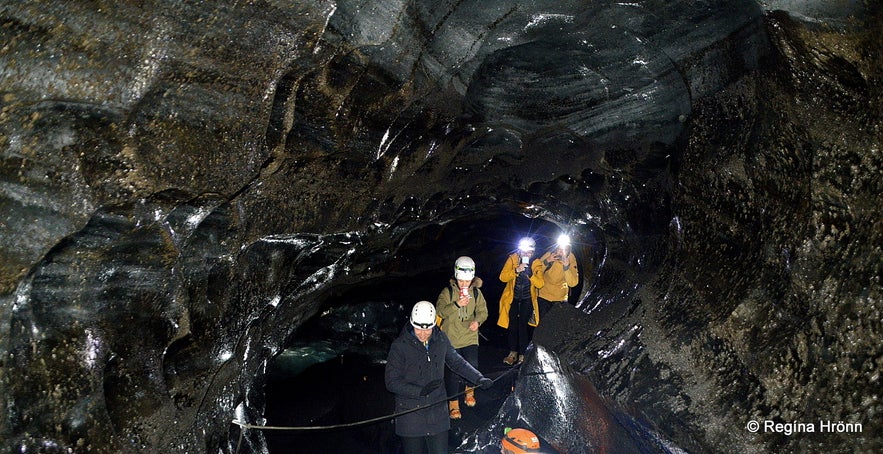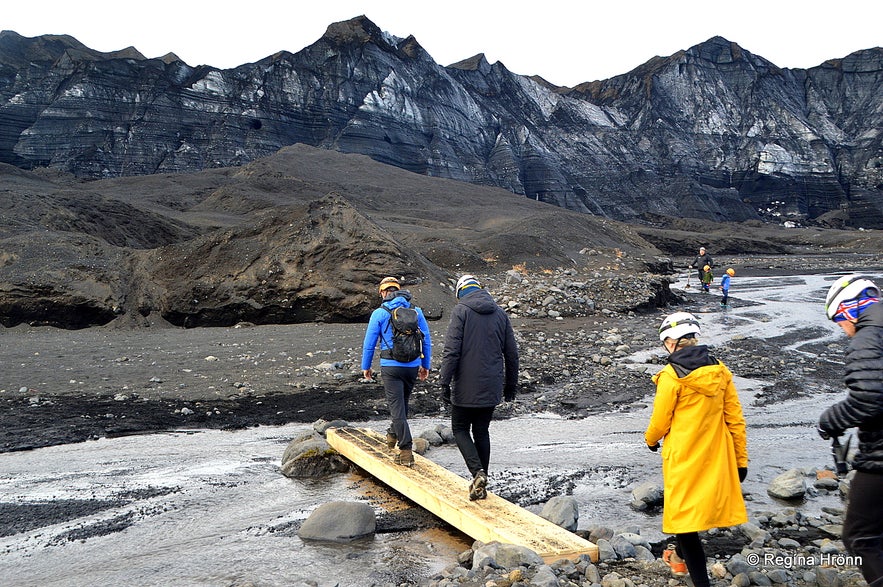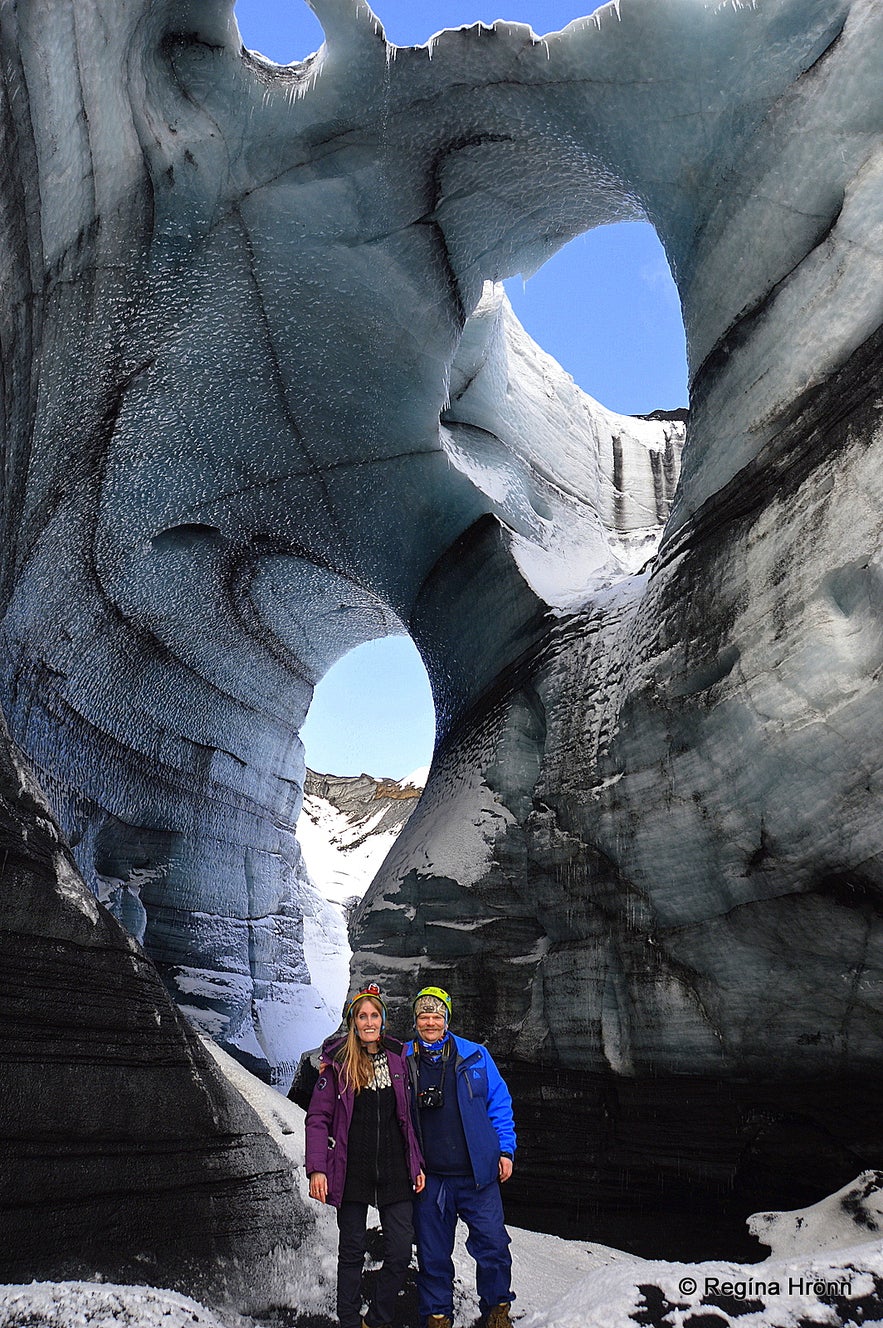
The Spectacular Katla Ice Cave in South Iceland

In this travel-blog I want to show you a couple of my visits to the Katla ice cave, in South Iceland, which is located much closer to Reykjavík.
Top photo: inside Kötluhellir ice cave
 Inside Katla ice cave
Inside Katla ice cave
I first visited Katla ice cave with Katlatrack, shortly after ice cave tours started in Kötlujökull. We drove from Reykjavík city to the scenic little village of Vík in Mýrdalur in South Iceland.
The Katlatrack glacier guides picked us up in their super jeeps at their meeting point at Vík (by the N1 gas station) right by ring-road 1.
The ice cave is a 45-minute drive north of Vík through black volcanic sand plains from previous eruptions of the still active Katla volcano (i.e. we have been waiting for it to erupt).
 This super jeep was waiting for us at Vík
This super jeep was waiting for us at Vík
Our guide blasted Highway to Hell on the radio, which I found to be both hilarious and fitting for where we were going - towards the notorious Katla, which most Icelanders are afraid of.
Another very active volcano in Iceland, Mt. Hekla, earned the nickname Gateway to Hell a millennium ago. When Mt. Hekla erupts we call it a tourist eruption - when Mt. Katla erupts we call it a cataclysm!
 Parts of Kötlujökull glacier
Parts of Kötlujökull glacier
That is why we Icelanders fear it, not that many of us have witnessed it erupting though, as the last eruption took place in 1918. But we have heard stories...
The ride is very scenic, through a ruggedly beautiful landscape with extraordinary contrasts. The pitch-black lava sand and the green mountains created a spectacular scene.
Soon it was to become even more spectacular.
 The track leading to the Katla glacier
The track leading to the Katla glacier
For such sandy roads, the driver lets some air out of the super-jeep tires (to around 12-16 psi) as it gives the tires a wider grip on the sand. The same is done when driving on glaciers in Iceland.
I tell you this so that you know what is happening on your upcoming tour when the driver suddenly disappears and starts fiddling with the tires ;)
 On the way to the ice cave
On the way to the ice cave
Once we reached the Mýrdalsjökull glacier the glacier guides provided us with sturdy glacier crampons and helmets with headlights.
One has got to appreciate the glacier crampons, they give us such good grips on the glacier hikes and inside the ice caves.
We now followed the guide on a short hike to the black icefall Kötlujökull - the Katla glacier. It was an easy hike, only 5-7 minutes or so.
We crossed a few creeks, with meltwater from the glacier, and in some places, the glacier guides had fitted planks over the creeks to make it easier for us to cross.
 The entrance to Katla ice cave in 2018
The entrance to Katla ice cave in 2018
When we reached the ice cave, I immediately thought to myself that it looked like a scene out of Game of Thrones or Lord of the Rings.
I was in awe just seeing the entrance to the cave. Don't you agree with me?
See also my travel-blog: The Extraordinary Game of Thrones Locations I have visited on my Travels in Iceland
The glacier guides had carved steps into the glacier to make it easier to ascend into the ice cave. You also have ropes to hold onto so it is easy to enter the cave.
Once inside you will have ropes and small bridges for your aid. Be careful here though.
 Inside Katla ice cave
Inside Katla ice cave
These beautiful ice caves are formed in the glacier tongues when water from the melting glacier finds its way and carves an opening in the ice.
Thus enabling us to have a rare peek inside.
And in this instance to walk through a black and blue ice tunnel with beautiful shiny ice formations.
 Aquamarine ice inside Kötluhellir ice cave
Aquamarine ice inside Kötluhellir ice cave
I love blue ice, which is the oldest part of the glacier. Why it is bluer is explained in detail by Nanna in her fantastic article Ice Caves in Iceland - the Ultimate Guide.
It is an essential read about glaciers and ice caves in Iceland in my opinion.
Our glacier guide picked up a piece of melting ice, shook it, and showed us some air bubbles trapped inside the ice.
 A piece of Kötlujökull glacier
A piece of Kötlujökull glacier
Inside the ice cave, you will see pitch black ash from different volcanic eruptions of Katla volcano through the centuries - ash which has been pressed into the ice and has never been seen before.
Since the Vikings settled Iceland back in 874 (give or take a few years) Katla has erupted some 20 times with the last big eruption taking place in 1918.
So it must be due to erupt if there is a pattern to its eruptions.
 Inside Katla ice cave looking out
Inside Katla ice cave looking out
The year of the last eruption in Katla, 1918, was quite an annus horribilis for Icelanders as it gave us an extremely cold winter, referred to as Frostaveturinn mikli - the Winter of the extreme frost - with 27 polar bears from Greenland coming ashore!
At the same time, the Spanish flu invaded Iceland. I as an Icelander was in awe and felt like I was walking through a tunnel of Iceland's history when I walked through the ice cave looking at the old ash from the Katla eruptions.
 Drinking the glacier - Icelandic Brennivín on the rocks - with ancient ice from the glacier
Drinking the glacier - Icelandic Brennivín on the rocks - with ancient ice from the glacier
When we reached the end of the ice cave we came out through another opening - and were greeted with a refreshing Icelandic Brennivín schnapps on the rocks!
Only the ice was age-old ice from the Kötlujökull glacier! Those who didn't want alcohol were offered water on the rocks.
I found it amazing being able to drink a toast to such forces of nature and somehow on returning through the ice cave I stepped more lightly and fearlessly. Or maybe it was because I had the flu and the alcohol went straight to my head ;)
 Cheers from Kötluhellir ice cave!
Cheers from Kötluhellir ice cave!
We spent an hour by the ice cave giving us ample time to take photos of every angle of the cave.
And you can take some spectacular photos of the ice caves.
My amateur photos don't even begin to show what professional photos can look like.
If you have a yellow coat then I would advise you to wear it during your visit to Katla ice-cave.
 Yellow color stands out when visiting the ice caves
Yellow color stands out when visiting the ice caves
I wore my blue parka but noticed that the best photos were of my fellow travelers who were wearing yellow. It makes you pop out of the photo.
I didn't know whether to use the flash or not in the ice cave, so I took photos left and right with flash and without flash to see which ones would turn out better.
The photos without the flash came out bluer, but with the flash, the ice lit up.
 Using the flash, the ash looks brownish and golden
Using the flash, the ash looks brownish and golden
Most of my photos in this travel blog are taken with flash. The flash, on the other hand, lights up the ash as well and makes it look brownish.
In previous travel blogs, I have shown you my visits to the seasonal crystal ice caves in Breiðamerkurjökull and Fláajökull glaciers, where the ice was blue and sparkling on the days I visited them.
 The staff of Guide to Iceland taking in the beauty of the ice cave
The staff of Guide to Iceland taking in the beauty of the ice cave
The glaciers are constantly moving so the ice caves change every year.
Each time you visit the ice caves they will look different, so the photos I show you here are just what they looked like on the days of my visit.
You can see a selection of good photos of the ice caves at Katlatrack.
The seasonal ice caves are open from the beginning of November until the end of March each year and can be visited when the weather permits. We never know though if or where they are going to form.
 Inside Kötluhellir ice cave
Inside Kötluhellir ice cave
Some years the most beautiful ice caves form and are never to be seen again. And new ones appear. So it is always a new and exciting experience visiting an ice cave.
The glaciers are constantly moving so the ice caves change every year.
Icefalls move under their weight and calve, so the glaciers and natural glacial ice caves cannot be visited without a trained and experienced glacier guide. We were in super good hands with the Katlatrack glacier guides.
 Leaving Kötluhellir ice cave following the guide
Leaving Kötluhellir ice cave following the guide
Never try to enter an ice cave without a trained glacier guide, as they always check out the condition of the ice caves before they enter them with a group.
Safety is of the utmost importance in ice caves, but this is nature, and there have been fatalities in ice caves.
 Mt. Hafursey
Mt. Hafursey
Above you can see parts of the beautiful Hafursey opposite the ice cave. Hafursey is a palagonite mountain standing tall on the black sandplains of Mýrdalssandur.
During one of the Katla eruptions, the glacial flood burst through a gorge in Hafursey on its way to the sea.
 Following our guide to Kötluhellir ice cave in 2021
Following our guide to Kötluhellir ice cave in 2021
If you are interested then you can read much more about the glacial floods in my travel-blog on Katla Volcano & Kötlutangi Spit
In the Katla eruption in 1755, some 6 men were able to seek shelter in a cave in Hafursey with the glacier burst roaring outside.
In my abovementioned travel-blog, you can read several stories about what happened to the inhabitants of this area during the glacier bursts.
 I love travelling in super jeeps and had a field day in the Katlatrack super jeeps ;)
I love travelling in super jeeps and had a field day in the Katlatrack super jeeps ;)
There are several tours available by Katlatrack:
Katla Ice Cave Tour | Departure From Vík - 4 hours
Fast Track Ice Caving Tour from Vík in South Iceland - 3 hours
 Katla ice cave in 2021 - the one we visited earlier had collapsed and another one was discovered close by
Katla ice cave in 2021 - the one we visited earlier had collapsed and another one was discovered close by
Under the Volcano - Super Jeep Tour from Vík
The Hidden Mountains - Super Jeep Tour from Vík which takes you f.ex. to Þakgil Canyon
 Inside Katla ice cave in 2021
Inside Katla ice cave in 2021
If you decide to visit the Katla ice cave from Vík, then you can rent a car in Reykjavík and drive to Vík in a couple of hours.
It is located 187 km away from Reykjavík with many beautiful stops on the way.
 Leaving Kötluhellir - following the guide
Leaving Kötluhellir - following the guide
Sólheimajökull is another glacial tongue stretching out from Mýrdalsjökull glacier.
Glacier hikes are very popular on Sólheimajökull, which also sports a small glacial lagoon. You can see what a glacier hike is like in my travel blog:
Glacier Hike & Ice Climbing on Sólheimajökull glacier in South Iceland
Have a fantastic time visiting the rare and beautiful ice caves of Iceland :)
Other interesting blogs
Chasing Waterfalls in Iceland
Iceland is spectacular in so many ways and Icelandic nature is quite unique with its vast landscape, volcanic activity, geothermal areas, glacier lagoons and sceneries, black sand beaches and spectRead moreSænautasel Turf House in the Highland of Iceland
In my search for turf houses around Iceland, I visited Sænautasel, which is a rebuilt turf house on Jökuldalsheiði heath in the highland of Iceland. It is, in my opinion, an extremely cute turf hoRead moreThe Dynamic Plant Lupine
People have been asking me where to find lupines in Iceland. If you like them you should be able to find them easily in Iceland in summer. They are in bloom and visible almost wherever you drive aroRead more

Download Iceland’s biggest travel marketplace to your phone to manage your entire trip in one place
Scan this QR code with your phone camera and press the link that appears to add Iceland’s biggest travel marketplace into your pocket. Enter your phone number or email address to receive an SMS or email with the download link.
















